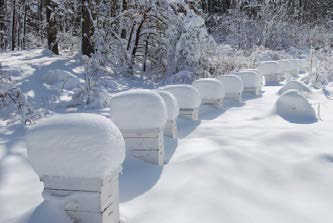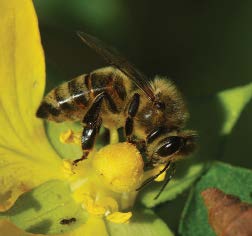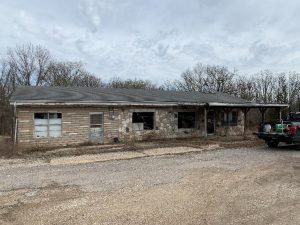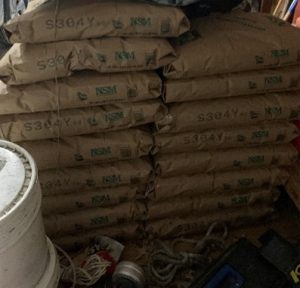Found in Translation
By: Jay Evans

Author Jay Evans
When this column comes out, many in the northern hemisphere will still feel the heat of a long Summer. Nevertheless, your bees will have already started preparing for the deadliest season in beekeeping, surviving the upcoming Winter. Winter for honey bee colonies involves a steady drip of worker bee losses, even when queens, food, and shelter are adequate. If you want your bees to raise healthy new progeny next spring, you either have to build up colonies to tolerate this drip or fi nd a way to patch the leak. Entering winter with a workforce that will still be here in the spring involves equal inputs from bees, beekeepers, and the surrounding environment.
By this time of year, good beekeepers have assessed and acted on mite issues and have doubled down to make sure a healthy queen is in place to produce the young bees that will be vital for surviving Winter. They also, where possible, have given their colonies access to safe and plentiful food. But what are the other predictors of overwintering success? How confident can a beekeeper be, year to year, that their colonies will be among the 60% that survive Winter? And what can be done to reduce those 40% losses, a crazy amount if you are raising bees for profit or not? There has been a tremendous amount of work lately focused on landscape-level nutrition and the impacts of climate on bee health across the seasons. This work benefits from field and lab experiments from scientists such as Dr. Gloria deGrandi-Hoffman, who describes an experimental study carried out with USDA and University colleagues in the open-access journal Insects (2021; “The importance of time and place: Nutrient composition and utilization of seasonal pollens by European honey bees (Apis mellifera L.)” https://doi.org/10.3390/ insects12030235). In this study, the impacts of regional and seasonal pollens on bee physiology were measured, showing differences in both pollen categories in the southwestern and midwestern U.S., and in the impacts of these pollens on bee health. There were also hints that bees of different queen lines have different preferences for pollens, perhaps triggered by different protein levels of those pollens. Can your bees be tuned to find and benefit from the pollens available locally? If not, how would a beekeeper provide those resources?

One way to tackle the latter question is to look at what is available from a bees-eye view. Dr. Martina Calovi and colleagues from Pennsylvania State University and USDA’s Agricultural Research Service used a survey-based approach to identify the environmental factors tied with colony health, and specially with overwinter survival. This study, part of the Beescape effort (https:// beescape.org/), merged publicly available environmental data with an intensive survey of Pennsylvania beekeepers and their colony dynamics. Their recent paper, “Summer weather conditions influence Winter survival of honey bees (Apis mellifera) in the northeastern United States” (Scientifi c Reports, 2021, 11:1553, https://doi. org/10.1038/s41598-021-81051- 8), relies on land use data collected by USDA-NASS (https://www.nass. usda.gov/Research_and_Science/ Cropland/SARS1a.php) alongside super-fine-scale (predicted every 400 meters) weather data to determine which environmental components are the best predictors of colony Winter survival. The former resource, the Cropland Data Layer, has been measuring acreage and land use since 1971, providing an amazing resource for the terrain available to bees, given land use and climate changes over the past 50 years.
September 2021 BEE CULTURE 31 In their paper, Calovi and colleagues first reconfirm that Pennsylvania beekeepers who treated for mites fared significantly better than those who did not, so much so that they had to analyze treated colonies separately from the (smaller) set of untreated colonies. Surprisingly, for Winter survival in this study, land use patterns had only a minor effect on colony fates. What really came through was a strong impact of weather patterns months before Winter even started on the abilities of colonies to make it through Winter. The most important variables in Winter survival were the ‘degree-days’ of Summer and summer precipitation. In a middle[1]ground sort of way, Summers and regions with moderate temperatures and rainfall supported bees with the highest odds of surviving Winter. Those in Pennsylvania who don’t have the means or desire to pick up their colonies and move will be comforted by the authors’ discovery that “No part of Pennsylvania was always good or always bad for honey bee survival; there was substantial spatial and temporal variability”, i.e., you will take your wins and losses due to a variety of factors but not necessarily your zip code.

Pictured by Chelsea Cook
I have mentioned it before, but Beescape offers multiple tools for beekeepers and researchers to connect open data for the environment (your tax dollars at work) with bee health measurements. They have now added a predictive tool for winter survival based on some of the work in this paper. Across the country, the main players in providing data on honey bee colony dynamics are the USDA National Agricultural Statistics Service (https://www. nass.usda.gov/Surveys/Guide_ to_NASS_Surveys/Bee_and_ Honey/) and the Bee Informed Partnership (www.beeinformed. org), a University-driven effort funded largely by the USDA’s Animal and Plant Health Inspection Service (https://www.aphis.usda.gov/ aphis/ourfocus/planthealth/ plant-pest-and-disease-programs/ honey-bees/honeybees). USDA[1]NASS has a decades-old database showing colony numbers by state and the productivity of those colonies. More recently, NASS added survey-based datasets measuring of colony losses and possible causes Chelsea Cook photo. for large and small beekeeping operations (https://usda.library. cornell.edu/concern/publications/ rn301137d?locale=en). Both connect management habits and general habitat-level data with colony fates. These datasets are rich and can be mined for insights into local bee hazards, from chemicals to poor forage, and climate factors that push bees over the edge. Using state- or country-wide models and “views[1]from-above” might not drastically change your beekeeping, but these efforts are slowly capturing the many ways that nature impacts your colonies. It is fascinating to think that, unlike most species with wings or strong legs, bees rely on the small sample of the world they can reach from their tiny painted houses.






